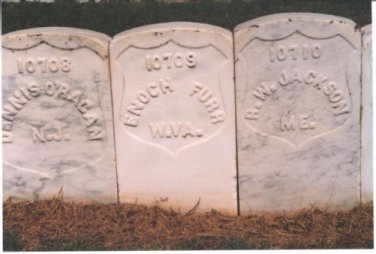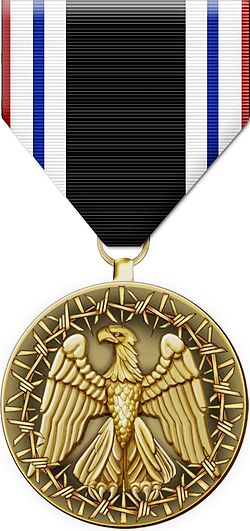Furr Prisoners of War

During our Summer 2001 family
vacation, we had the honor of visiting the National Prisoner of War Museum at
the Andersonville National Historic Site. We
were deeply move by the experience. John and Rachel worked on and
earned their Junior Ranger badges, while Martha, Billy, and I learned about
prisoners of war from the Revolutionary War to the Persian Gulf
War. We found out that two Furrs (Enoch Furr of
I know these are not the only Furr prisoners of war. For example, my
great grandfather, William Meek Furr, was captured at
Click here for the story of one Furr POWs – PFC Paul Edward Furr
AMERICAN CIVIL WAR
ADAM M. FURR
Private, 4th North Carolina Cavalry, Company E –
enlisted Cabarrus County, NC, July 7, 1862 (age 20); captured South Mountain,
Virginia, July 4, 1863; confined Fort McHenry, Maryland; transferred Fort
Delaware, Delaware, July 9, 1863; transferred Point Lookout, Maryland, October
22, 1863; died January 28, 1864 of an "incise wound" received during
a fight. He is buried in the
ALLISON FURR
Private, 7th North Carolina Infantry, Company B –
captured at the Battle of Gettysburg and confined at Point Lookout, Maryland,
where he died on January 6, 1864. He is buried in the
CHARLES FURR
Private, 29th North Carolina Infantry, Company A –
captured Chickamauga, September 20, 1863. Exchanged
ENOCH FURR
Private, 10th West Virginia Infantry, Company K – died
of diarrhea on October 11, 1864, at Andersonville Prison,
Georgia. He is buried in the
F.M. FURR
Private, 41st Georgia Infantry, Company E – captured Champion Hill, May 16, 1863, transferred Fort Delaware, June 9, 1863, exchanged July 4, 1963.
FRANKLIN FURR
Private, 14th Alabama Infantry, Company B – died in the Cliffburn Barracks Hospital in Washington, DC on May 29, 1862, buried Arlington National Cemetery.
GEORGE M. FURR
Private\Corporal, 4th Mississippi Infantry, Company K
– captured Fort Donelson, February 11, 1862,
sent to Vicksburg for exchange, September 11, 1862. Captured at
H. FURR
2nd Sergeant, 56th Georgia Infantry, Company I –
captured at
IOHA FURR
Private, 17th Iowa Infantry, Company I – prisoner,
Andersonville Prison, Georgia, exchanged
J. PINKNEY FURR
Private, 8th North Carolina Infantry, Company H – captured at Gaines Mill, June 1, 1864, sent to Point Lookout, Maryland, June 11, 1964, transferred to Elmira, New York, July 12, 1964, released June 11, 1965.
JOHN B. FURR
Private, 1st Regiment North Carolina Artillery, also shown
in 10th North Carolina Infantry, Company B – captured at Fort Fisher,
January 15, 1865 and confined at Elmira, New York where he died March 3, 1865
of variola. He is buried in the
JOHNSTON
Private, 23rd Virginia Cavalry, Company D – captured Clark County, Virginia, February 7, 1865.
JOHNSTON
2nd Lieutenant, 47th (Crandall's) Arkansas Cavalry Regiment, Company D – captured Woodruff County, Arkansas, December 14, 1864, died of dysentery at Little Rock, Arkansas, Federal Prison on April 23, 1865.
LAWSON ALEXANDER FURR
Private, 28th North Carolina Infantry, Company K –
captured Hanover Courthouse, May 27, 1862, transferred to Fort Columbus, New
York Harbor, captured Wilderness, May 12, 1864, sent to Point Lookout,
Maryland, May 18, 1864, transferred to Elmira, New York, August 10, 1864, died
of pneumonia on December 6, 1864, Elmira Prison Camp, New York. He
is buried in the
MARTIN FURR
Private, 3rd Battalion North Carolina Light Artillery,
Company C – captured Fort Fisher, North Carolina, January 15, 1865;
confined Elmira Prison Camp, New York, where he died of typhoid fever on
February 23, 1865. He is buried in the
Paul M. FURR
Sergeant, 43rd North Carolina Infantry, Company F – released from Camp Chase, Ohio, in 1865.
RICHARD B. FURR
Captain, Franklin's 7th Missouri Infantry Regiment –
captured Lewis, Ohio, October 29, 1862, died in Federal prisons in St. Louis,
T.M. FURR
Private, Mosby’s Calvary, Company A -- captured
WILLIAM MEEK FURR
Private, 19th Mississippi Infantry, Company E – captured Germanna Ford, Virginia, April 26, 1863; confined Old Capitol Prison, DC, May 1, 1883; exchanged City Point, Virginia, May 10, 1863.
WILLIAM S. FURR
2nd Lieutenant, 6th Arkansas Infantry, Company H – captured Jonesboro, Georgia, September 5, 1964, transferred to Johnson’s Island, Ohio, November 22, 1864, released Jun 18, 1865.
WILSON M. FURR
Private, 28th North Carolina Infantry, Company D -- wounded on 06 May 1864 at Wilderness, Virginia, hospitalized on 08 May 1864 at Washington, DC, confined on 07 September 1864 at Old Capitol Prison, Washington, DC, transferred on 19 September 1864 at Fort Delaware, Delaware, took Oath of Allegiance on 19 June 1865 at Fort Delaware.
WORLD WAR II

COY L. FURR
GEORGE WASHINGTON FURR
Telegraphist
HUGH H. FURR
INGRAM OSBURN FURR
Seaman, second class, US Navy, captured 1942, Philippine Islands, Status: returned, Where Held: Tokyo Sectional Camp #3, Hiraoka, Nagano, Tykyo Bay Area 35-139, Home State: Mississippi.
MARVIN D. FURR
Private First Class, US Army Corps of Engineers – captured 1943 Sicily, Status: returned, Where Held: Stalag 7A Moosburg Bavaria 48-12 (Work Camps 3324-46 Krumbachstrasse 48011, Work Camp 3368 Munich 48-11), Home State: North Carolina.
PAUL E. FURR
Private First Class US Army (17th Ordnance
Company) -- captured 1942 Philippine Islands, Status: returned, Where Held: Hakodate POW Camp-Babai
-
PAUL R. FURR
WILLIAM W. FURR
First Lieutenant, US Army Air Corps (352nd Fighter Group, 328th Fighter Squadron)
– captured 1944
Mustang Leveled Headquarters of Nazis, Who Fired at ‘Chuting Pilot
By BILL WOMBLE.
Quite by accident, but nonetheless quite effectively, First Lt. William Wade Furr of Raleigh, 24, Army fighter pilot ace, struck his most telling single blow at the Nazi at the moment his P-51 Mustang warplane “conked out” over enemy territory a year ago, forcing him to bail out and float down to certain capture.
Lieutenant Furr, veteran of nearly five years of active Army
duty, and son of Mrs. P. E. Furr of
Destroyed Headquarters.
When the burning and disabled Mustang hurtled to earth, the ship struck a French farmhouse squarely, causing the whole building to disintegrate. The 300-odd gallons of gasoline still left in the Mustang's tanks helped no little in the destruction wrought by the ship. The lieutenant could see it all as he swayed beneath his silk canopy.
“I learned soon after they captured me that this farmhouse was field headquarters for a German air unit,” said Furr, indicating by his smile that such information was considerable consolation to him for having lost his ship and then suffering capture.
His “swan song” from action and the Mustang's
death dive occurred on June 5, 1944, southeast of
The Raleigh fighter pilot, who holds two Distinguished Service Crosses, four Air Medals, the Purple Heart, and other decorations, said the Nazi ground gunners took pot-shots at him as he floated to earth, and only the fact that a 45-mile gale was blowing saved his life. He was hit in one leg by shrapnel from a 20 mm. shell, but was not dangerously wounded.
“The high wind interfered with their aim,” he said, “and they couldnt’ get the shells close enough to me. Had it not been blowing so hard, I'm sure they would have riddled me before I could get down.”
As it turned out, the Germans were waiting for him as he struck earth, and he didn’t have a chance to get away, he said. He added it was two weeks before he was able to get treatment for his wound. By that time the wound had become infected.
Over Nine Victims.
Lieutenant Furr has been credited in Army Air Force press releases with destroying nine and one-half German planes, two of them on the ground. The modest young pilot said he personally did not know as yet of credits for but seven planes. He added he had not received official notice of results of examinations of movie films of his last few actions, hence this might account for the difference.
Every fighter ship, he explained, is equipped with an automatic camera that records each action. The camera starts operating as the pilot presses his gun trigger.
Shortly after his capture, Lieutenant Furr related, he was
transferred to a prisoner of war camp south of
It was march, march, march on these transfers, the Raleigh pilot said, and a number of men suffered frozen feet. Furr was so stricken, but not severely, and he said his feet now bother him only in cold weather.
On the last transfer, which involved about 300 miles of
travel, Lieutenant Furr said the prisoners were packed into a boxcar. He
doesn't recall exactly how many days he was in the car, but believes it was
about eight. Finally, he arrived at Moosburg, in
Other
By the time that elements of General Patton’s army arrived in April to free the Americans, Lieutenant Furr was in company with four other captured Raleigh men—Lt. Col. Joseph Matthews, Capt. Fitz Davis, Capt. Al Johnson and Capt. Charles Jennette.
Asked about the treatment he received while a prisoner, Lieutenant Furr said “it wasn’t too bad.” He added he would rather not talk in detail on this point at this time.
With plenty of time in which to think and form opinions of Germany and future peace, most of the men in his camp had done just that, Lieutenant Furr said, and they felt that the United States must share to a large degree the responsibility for remaking Germany, if that is possible.
“They're thoroughly whipped,” he said, “and they know that they are whipped, but they’re not admitting it. If they are treated this time in the same manner as they were after the last war, we will have no one but ourselves to blame, should they make a comeback as a military nation.”
To the Allies’ air forces belongs the credit for crippling the Nazis to a degree that they could not stand off either the invasion of France or the over-running of their own country, Lieutenant Furr believes.
Many Fanatics.
During the three-hour battle around his prison camp at Moosburg, Furr said he saw a sample of the fanaticism which prolonged the war far beyond its logical end. Hitler’s SS troops and members of the Gestapo were shooting camp guards who wished to surrender, he said.
Earlier, he had heard fellow prisoners tell of German boys, some as young as 12 years, who manned machine guns in hopeless last-minute stands. These boys, members of Hitler's youth organization, would not quit under any circumstances, Lieutenant Furr was told by American infantry officers, and they had to be shot in combat.
Lieutenant Furr, following a furlough here, will report for reassignment.